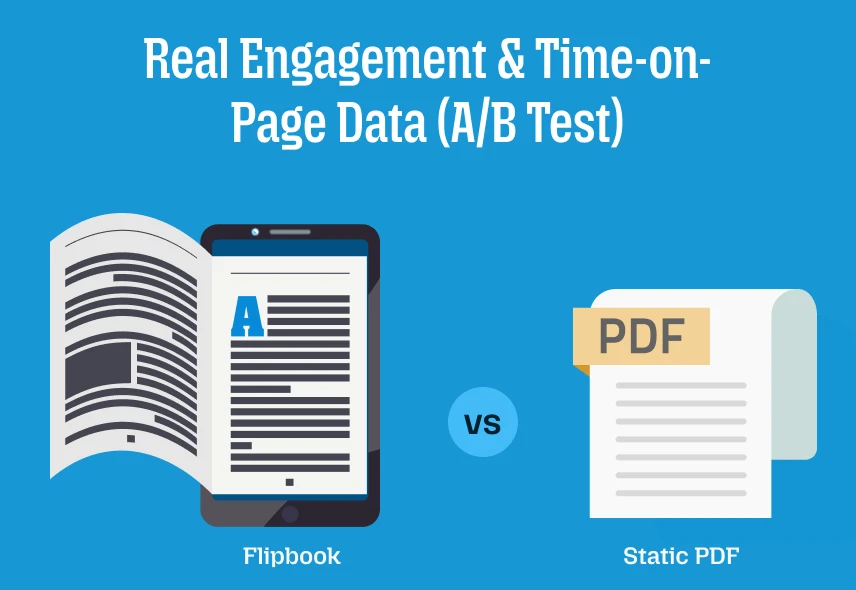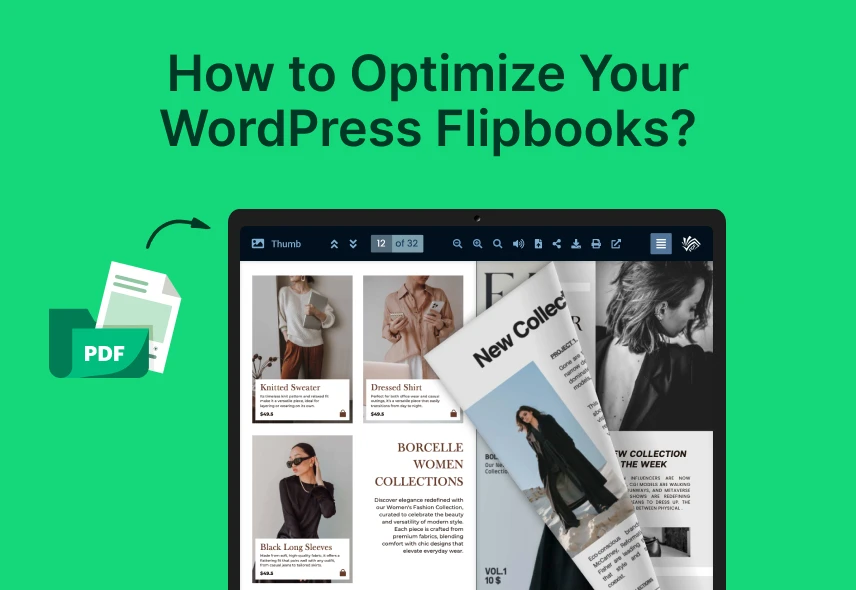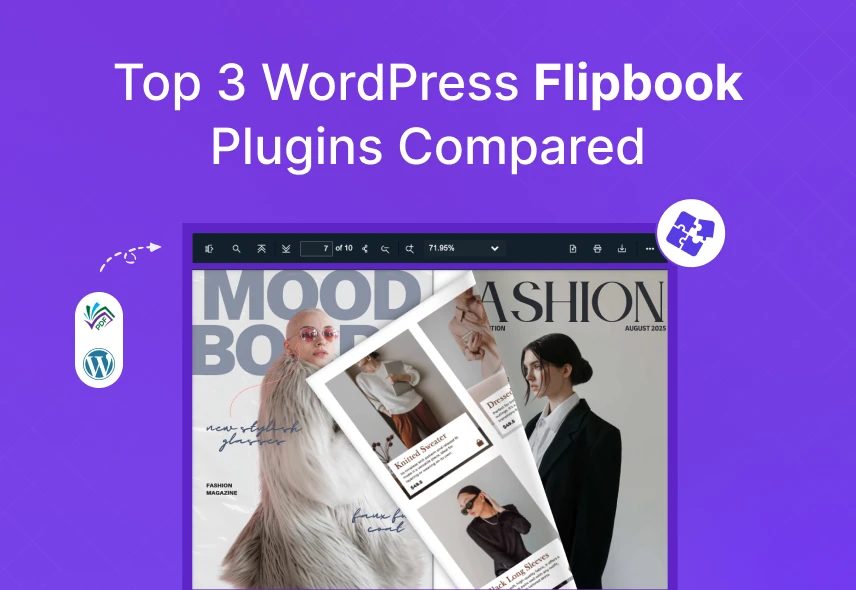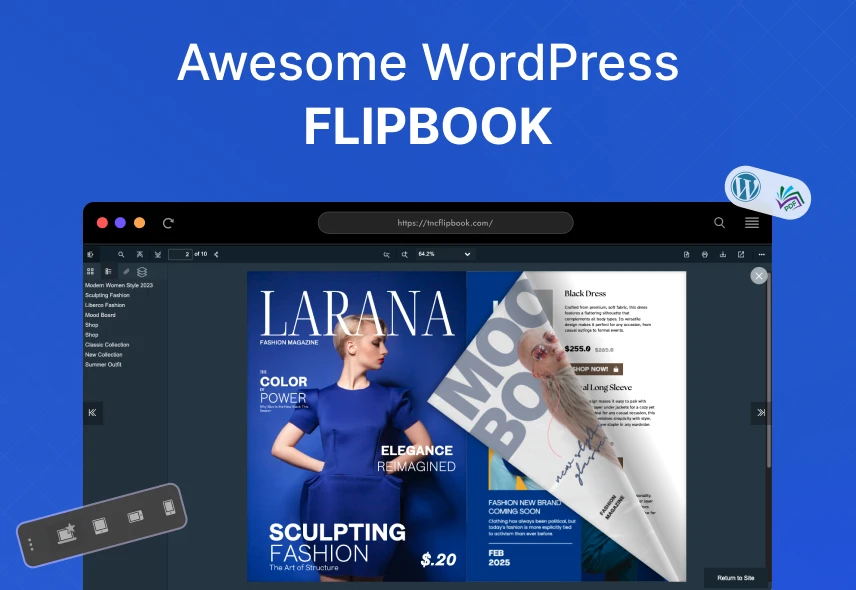It’s a digital showdown. We are putting two popular content formats against each other: interactive flipbook vs static PDF. Which format increases reader engagement and keeps visitors on the page longer? Both serve to deliver information. Nothing could be more different in terms of their impact on visitor engagement and “time-on-page” metrics.
An A/B test comparing flipbook engagement stats and traditional PDFs reveals significant insights worth exploring. If you choose the best way to share digital content, it can have a huge impact on how much your audience interacts with your content. Let’s see how flipbooks and static PDFs compare in terms of actual reader engagement and time spent.
What Are Flipbooks & Static PDFs?
A PDF is a digital copy of a printed document. We often download it, then quickly skim it. A flipbook offers an immersive experience. It works like a real book with page turning and embedded media. Flipbooks also include interactive elements. Let’s see:
PDF: Static PDFs are basic digital documents. They are like printed papers with no moving or interactive documents.
Flipbook: Flipbooks are interactive documents that look and feel like real books. You flip pages digitally and often find videos, clickable links or even sound inside.
Key Metrics to Track Engagement
You need to understand how users interact with your content. Essential metrics include:
- Views: How many times your document or flipbook is opened.
- Pages Viewed: Number of pages a reader flips through per session.
- Time Spent: Duration readers spend on individual pages or the entire document.
- Hotspot Interactions: Clicks on embedded videos, links, galleries, or other interactive elements.
Flipbook Engagement Stats vs PDF: What the Data Shows
1. Total Views & Reach
Both static PDFs and flipbooks can be widely distributed. Flipbooks allow tracking of unique link views and notify when the document is opened. Enables better follow-up.
2. Pages Viewed & Read Depth
- Flipbooks generally achieve more page views per session. The main reason is that the page-turning effect encourages browsing multiple pages.
- Analytics show that readers often spend more time on each page within flipbooks, especially pages enriched with interactive content like videos or audio hotspots.
- Static PDFs do not have this engagement queue. This is why they result in faster scanning or faster exit.
3. Time-on-Page
- Flipbook readers stay on pages longer. Average time spent metrics perform significantly better than PDF.
- On desktop, flipbooks display two pages at a time and divide viewing time accordingly. Yet they report higher engagement than static PDFs.
- Hotspot-enabled flipbooks hold users’ attention as they interact with embedded items. This creates better engagement than static PDFs.
4. Interactivity and Hotspot Clicks
- Static PDFs remain limited to basic link tracking.
- Flipbooks enable rich interaction tracking. Includes clickable videos, galleries, and audio to increase the stickiness of the content.
- Flipbook analytics offer powerful insights. Heatmaps highlight areas users focus on, while click statistics show exactly what they interact with.
A/B Testing: Flipbook vs PDF Summary Table
We conducted an A/B test where we delivered the same content in two formats: a static PDF and an interactive flipbook. Let’s explore:
| Metric | Flipbook | Static PDF |
| Total Views | Trackable with unique links, real-time | Track views, but less interactive tracking |
| Pages Viewed | Higher average pages per session | Lower, passive scrolling |
| Average Time on Page | Longer, especially on interactive pages | Shorter, less immersive |
| Interactivity | High (videos, audio, links, galleries) | Limited to static links |
| Analytics Detail | Detailed page-level & hotspot stats | Basic view and time metrics |
| User Experience (UX) | Engaging, book-like with animations | Static, less engaging |
| Follow-Up Capability | Yes, with notifications & tracking | No |
Why Flipbooks Win for Engagement?
Flipbooks make online reading a great experience. They work just like real books. It makes reading fun and keeps people interested. Flipbooks work well on websites and help your site appear higher in search and make it easier for people to use. You don’t need to download them. You can open them instantly on any device. Since they are very easy to access, more people will read your content.
Flipbooks also give you useful information about your audience. They track what people do on every page. It shows you exactly what they look at and click. This gives marketers and sales teams instant updates on who’s reading their content. It helps them follow up quickly and effectively. All this engagement means people remember your information better and feel more connected to your brand.
Visual Chart: Flipbook vs PDF Engagement
Let’s see how flipbooks and PDFs stack up on the most important stats. We used the TNC FlipBook plugin for our WordPress site to create this visual chart. We compiled the same information into a static PDF and a flipbook and then got the results.
Click here to view the live demo
Strategic Impact on Real-Time Engagement
Our A/B testing data clearly shows that flipbooks drive meaningful engagement and understanding of your audience.
Content ROI: Gain deeper insights into what resonates with your audience. You can optimize your content strategy, which leads to a better return on your content investment.
Lead Generation: You can add forms and other interactive elements directly inside your flipbooks. This strategy improves your efforts to generate new leads.
Brand Storytelling: Flipbooks allow for more dynamic and engaging storytelling, which helps your brand shine online.
Sales Enablement: Sales teams can use flipbooks as interactive presentations. You can tailor them to specific client needs and track participation during sales calls.
Marketing Campaigns: Integrate flipbooks into your email marketing, social media, and website to create more engaging campaigns.
Best Practices for Improving Flipbook Engagement
You need to add fun things like clickable buttons and pop-up images to make your flipbook more engaging. Try adding unique features that most people don’t use. For example, include quizzes or polls inside the flipbook to actively engage readers. These make readers want to keep looking at more pages. Make it easy to navigate by adding clickable menus or links to important sections. Test how it looks on different devices. Optimize content to make sure everything is clean, easy to use, and loads quickly.
Use your flipbook data to see which pages people like and where they click. Notice where readers stop reading and fix those parts to make them better. Keep your flipbook simple and same colors and style all through. Use clear, bold calls to action that guide readers on what to do next, like signing up or sharing the flipbook. Don’t forget to share your flipbook on social media with catchy captions and hashtags to reach more people.
Conclusion
Our test shows flipbooks get much more engagement than regular PDFs. The A/B test and real engagement data clearly show that flipbooks outperform static PDFs in reader engagement and time-on-page metrics. People spend more time with them, click more links, and view them more often. Regular PDFs don’t attract as much attention as flipbooks.
If you want your marketing to work better, switching from plain PDFs to interactive flipbooks is a smart move. Use the built-in tools in flipbooks to watch how people read and click. This helps you improve your content and makes it easier for your audience. Flipbook is the future of engaging, trackable, and interactive documents
Stop using plain PDFs and switch to the exciting world of flipbooks. Your audience will thank you and your engagement will expand. Click here to read more blogs.






0 Comments